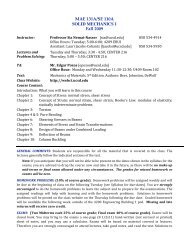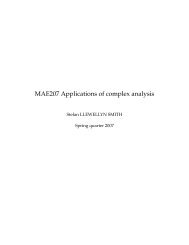Create successful ePaper yourself
Turn your PDF publications into a flip-book with our unique Google optimized e-Paper software.
, 1<br />
3 ,<br />
, <br />
3<br />
3,<br />
2<br />
<br />
<br />
<br />
3 ,<br />
4 <br />
<br />
3 <br />
, <br />
4 <br />
<br />
3 <br />
, <br />
Note that this problem did not specifically ask for the minimum power required at sea level. Hence, other<br />
selected values of velocity can be selected and will yield different power requirements. These will be plotted in<br />
the Numerical Substitution section. The required power is given by,<br />
<br />
Substituting the equation derived in Problem 6.1 for the required thrust, , into this equation for required<br />
power yields,<br />
2 <br />
/<br />
1<br />
2 <br />
, <br />
The maximum velocity, , will occur when the aircraft it at full power. The maximum power available is given<br />
by,<br />
<br />
This equation can be substituted into the equation for the required power, , and then solved for . However,<br />
the resulting equation is a fourth-order polynomial and, although closed-form solutions to this problem do exist,<br />
the simplest way to solve this problem is by graphical means. This will be done in the Numerical Substitution<br />
section. Finally, to find the required power and corresponding velocity at a different altitude, the following<br />
equations are used:<br />
, , <br />
/<br />
<br />
/<br />
where , is the required power at sea level, which we found in part (a), is the sea level air density, and is<br />
the maximum velocity at sea level. To solve for the maximum velocity at a different altitude, the available power<br />
must first be adjusted. It is given that the power available is proportional to the air density and so the following<br />
equation must hold:





